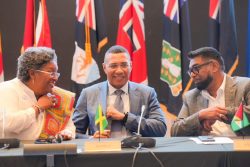By Jeff Trotman
The board of directors of the Linden Enterprise Network Inc. (LEN) is not a reflection of the wishes of the people of Linden. Chairman of the Linden IMC, Orrin Gordon made the criticism on January 29th at a press conference he called immediately after the seven-member board was inaugurated.
“It is a government board,” Gordon bemoaned. “It’s not a board like how it was in LEAP or LEAF time. It is government appointed.”
Stating that he does not have any quarrel with the board of directors, personally, Gordon contended that “the board is not accountable to the people”. According to him, LEN is supposed to be an indigenous organization with representation from the broad mass of people in the community and, therefore, the board should have been made up of people from the general stakeholdership of the town; additionally, terms of reference should have been established to determine the way forward. “This should have been a sub component of the entire regional system – of the regional economic programme. This would have been one of them and this would have been looking after some specific aspects – not the whole thing because government would still have to play its part … because LEN don’t have the full resources to do it.”
Economic plan
He said in 1994 there was a forum at the New Silvercity Secondary School at which number of presentations were made on education and economic development and after that meeting, the government sent Bharrat Jagdeo, who was a junior minister at the time, and an economic strategic plan for Linden and Region Ten was formulated.
“The community has never seen that plan,” Gordon said. “So, although, the government is saying that there is this plan, we have never seen that plan. Subsequently, we received some information about this plan and one of the things was that if ten businesses want to do business in Linden, they would go to Dalawalla where an Export Promotion Zone would be established. At that time, we had major issues with that and so that died.
“They then moved on and said that a part of this thing was you had special concessions for businesses that were going to open in Linden and therefore, you were entitled – but that again was nebulous. Nobody could tell you definitively what this thing entailed. So, I don’t know, who benefitted from that concession, or duty-free concession for equipment or plant, or whatever. That was one aspect of this supposedly Linden plan that we have never seen. I have never seen it and most people in Linden can’t tell you that they have seen a document outlining this development plan for Linden.
“Eventually, the European Union decided that they would come to see what’s happening. The European Union has always been involved in Linden’s development in many ways. In the past, we have had excellent relations with the European Union. So, the European Union, realizing that bauxite was basically going down, decided that we (Linden) needed to diversify. This is the genesis of this programme.
Identification study team
“They then sent a team here called the Identification Study Team in 1998 and it fanned out for about ten days within Linden and they went to Moblissa, they went all over the place; there were different groups, dealing with different things – some with social, some with agriculture, infrastructure, etc. Then they did a presentation at the Linmine Constabulary Hall when they were finished and they agreed that the loan composition would have about six components – and one of the things that they agreed was that the loan component would have been a revolving loan that would comprise half of the total amount of €19.5M. So €10M would have gone to the revolving loan and the €9.5M would have gone to technical assistance, etc.
“From the time of the identification to the time of the implementation and the passage of money a lot of consultations were taking place between government, the Region and the community. I remember one, in particular, right in the Regional Boardroom where he government sent a team headed by a number of their experts … and one of the things they came to us with was that the money for loans was not only for Linden or exclusive to Region Ten people; it should be for general – broad.
“We did not agree to that. We said that we should benefit for, at least, two, three years, before broadening the thing if you find that Linden don’t have the capacity. But, in essence, we are not agreeing to that.”
Decreased funding
Gordon added: “By the time the project came back to us that revolving fund moved from €10M to €3M and the rest of the component remained the same. So, the €9.5M and €3.3M became €12.8.”
He said the programme involved a lot of technical assistance, bringing people from Europe, from outside of Guyana “and that was one of the things, we had argued against. We said utilize local resources ….”
Acknowledging that effective work was done on institutional strengthening, Gordon disclosed that the IMC received computers and was upgraded in other areas. He said a wood drying kiln was earmarked for the Linmine Technical Institute but that never materialized. He said the Linden Chamber of Commerce hired a paid coordinator.
He noted that some infrastructural work was also done including the Moblissa Road and some work in agriculture in the form of assisting people to cut down trees in preparing farm lands.
Review
Gordon said there were review sessions at which there was general agreement that some of the set parameters were ambitious, making some of the goals unattainable. According to him, although there were mixed reviews regarding the successes of set goals, there was no doubt that the project lifted the entrepreneurial spirit within the community.






